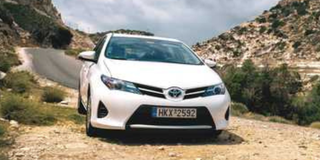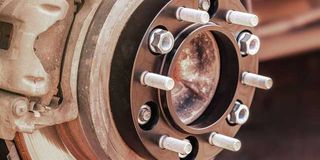
The Auris version of the Corolla is exceptionally low-slung and sleek, designed to target customers wanting a “sportscar” look.
I have a Toyota Auris that is very low and scrapes its front valance on speed bumps. Can I make it higher? CS
The best time to ask this question is before you buy a car with low profile tyres and the ground clearance of a roller skate.
For ordinary motoring these design attributes are a fashion statement. Their practical advantages are limited to motoring at very high speeds on very smooth roads. Only.
They tend to be lighter and sleeker for better aerodynamics, they have low-profile tyres for better stability at very high speeds, the low front valance acts like a “splitter” to deflect airflow sideways and over the roof to create low pressure under the floor (so-called “ground effect” ) that sucks the car down to improve straight line stability and cornering grip...all of which come into useful effect only if and when you are driving at something close to double (!) the national speed limit.
In every other circumstance they add nothing...or a handicap. They are less comfortable on rougher roads, more prone to pinch-punctures on pothole edges and rocks, more likely to get stuck in the mud (because the low floor “bellies” on ridges between ruts), have lower driver eye levels in traffic, can be a grunt or a head-bang to climb out of, and on really rough roads can be reduced to a floor-grinding or panel-bending or bump-stop bashing crawl. Or simply no-can-do.
In Kenya’s general motoring conditions, they are as anomalous as a Chelsea Tractor in central London. The recipe for general versatility in Kenya is higher ground clearance, longer suspension travel, relatively big overall tyre diameter with a smaller rim but taller tyre wall for more air cushioning.

The recipe for general versatility in Kenya is higher ground clearance.
Modern sporty design not only heads in the opposite direction in all those respects; but is also more difficult to modify. Yes, you can increase its ride height, but the low body and big wheel rims do not leave much room for a higher profile tyre without also adding longer suspension travel; spacers would interfere more with handling and looks; as would body mods to shorten or raise the overhangs. And, increasingly, cars now have longer noses – the front bumper is further in front of the front wheels to allow for a super soft , sloped and low level initial crumple zone...for the sake of pedestrians. Traditionally basic mods at low cost are now more complex and more costly.
The Auris version (now discontinued?) of the Corolla is exceptionally low-slung and sleek, designed to target customers wanting a “sportscar” look. Perhaps exactly the image you wish for. But we do not have many sportscar roads, and whenever we do the authorities build tarmac logs across them.

Without major modifications at high cost, sports models virtually disqualify the standard “lifters” like high profile tyres, longer springs, spacers, extended top mountings for their springs and bodywork.
Another “lifting” option is to fit taller suspension components (and/or “spacers”). These will lift the bodywork further above the road, but they will not raise the minimum (lowest point) ground clearance, which is usually the differential housing. So without major modifications at high cost, sports models virtually disqualify the standard “lifters” like high profile tyres, longer springs, spacers, extended top mountings for their springs and bodywork.
More generally, on almost any make or model of car very-low profile tyres (now common on used imports from other markets) are an anomaly on Kenyan roads. How can I say this politely? “They are not a good idea”.
The “profile” of a tyre is the ratio of its width to its sidewall height. The “standard” profile over many decades has been a sidewall 83 per cent of the width. A bigger percentage than that is now “high” profile. A lower percentage is “low” profile. Most tyres are now low profile between 65 per cent and 75 per cent. That’s the new normal.
That pattern does not necessarily reduce ground clearance, because in parallel with the trend towards lower profile tyres has been the fitting of larger-diameter wheel rims. Today, many rims are 15-19 inches. One trend off-sets the other, as ground clearance is primarily determined by the radius from the outside tread to the centre of the wheel hub minus anything hanging below the hub.
For very high performance cars (those that warrant tyres of H or V speed rating) used almost exclusively on smooth tarmac, including motorways with ambient speeds of 130 kph or more) a profile as low as 60 per cent is still just viable here for in-city and highway users. More than a few models on the market are now even lower.









